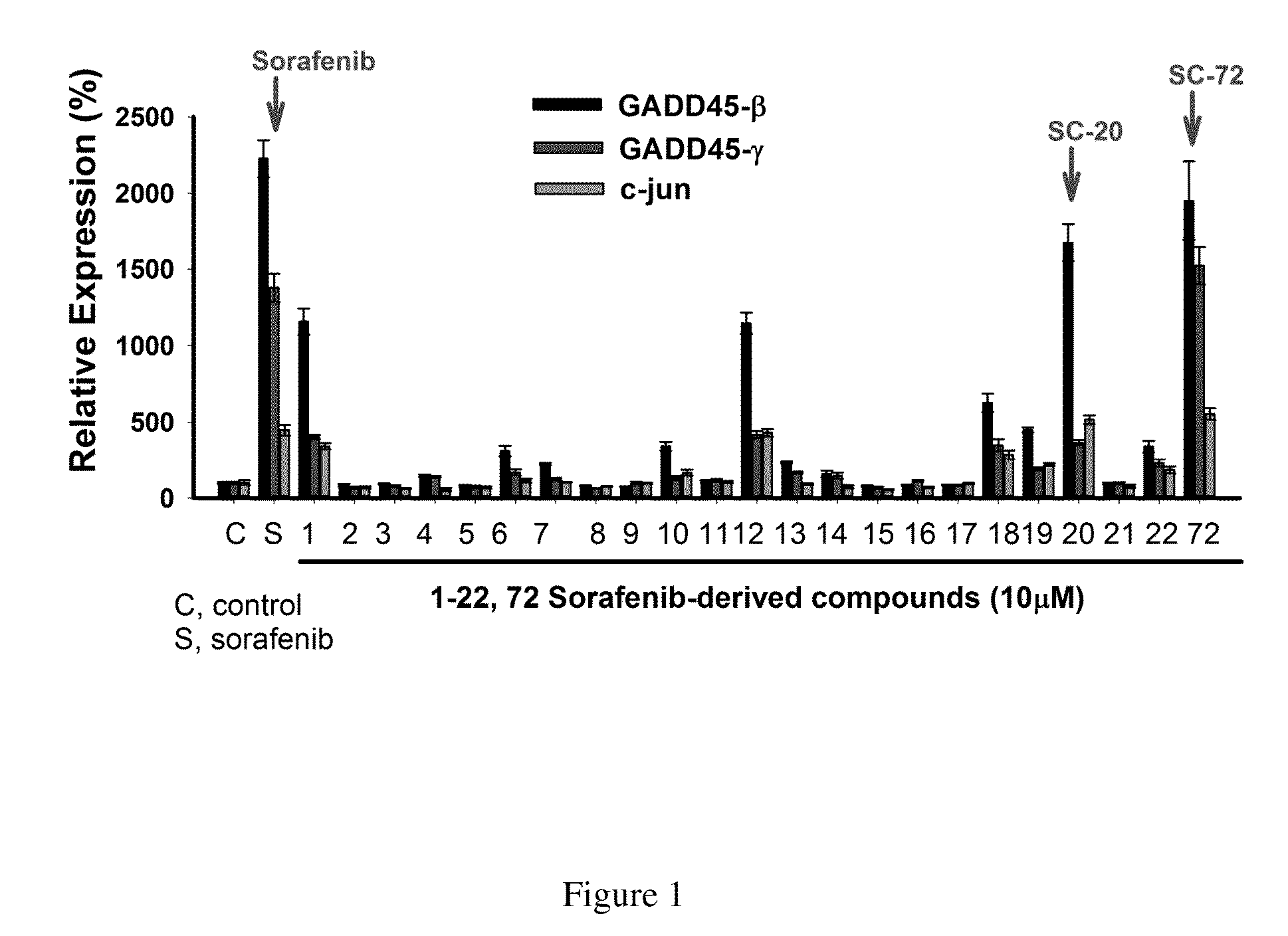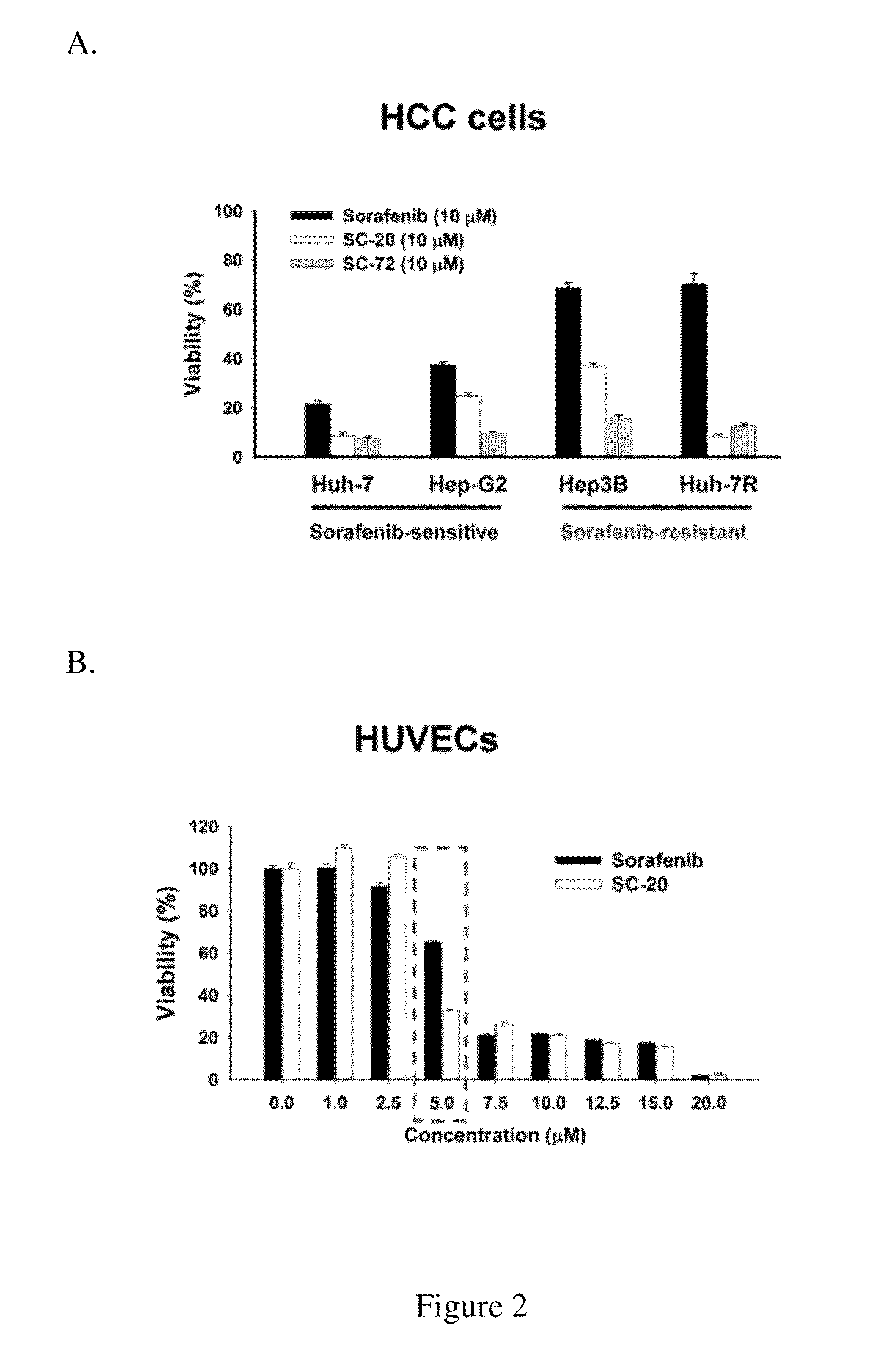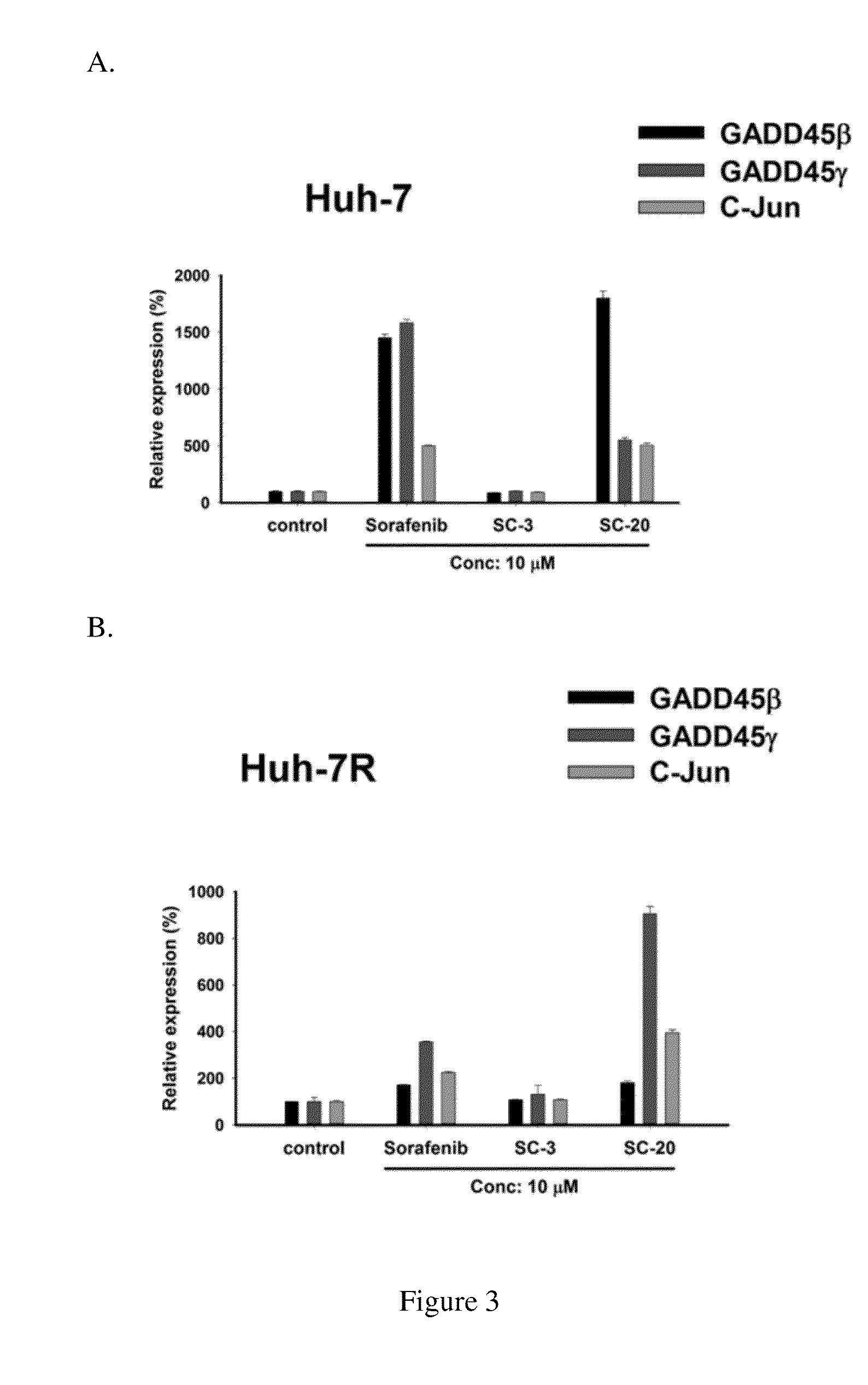Method for screening Anti-cancer drugs and method of cancer treatment
a cancer treatment and anti-cancer technology, applied in the direction of biocide, drug composition, instruments, etc., can solve the problems of poor prognosis, ineffective treatment, difficult to identify the sub-population of patients, etc., to achieve sufficient time, increase the expression level, and the effect of sufficient tim
- Summary
- Abstract
- Description
- Claims
- Application Information
AI Technical Summary
Benefits of technology
Problems solved by technology
Method used
Image
Examples
example 1
Drugs Screening Platform
[0048]It was tested a series of the above derivatives lacking Raf inhibitor activity for their effects on GADD45 induction in HCC cells.
[0049]For in vitro experiments, the candidate compounds (e.g. the series of SC-20 and SC-72 derivatives) were dissolved in DMSO, and the final concentration of DMSO was kept below 0.1%. For in vivo experiments, SC-20 and sorafenib was dissolved in Cremophor EL / 95% ethanol (50:50; Sigma-Aldrich).
[0050]Cell Culture and Candidate Compound Treatment
[0051]Huh-7 cells, a HCC cell line, were cultured in Dulbecco's modified Eagle's medium (DMEM), containing 10% fetal bovine serum, penicillin (100 units / mL), streptomycin (100 μg / mL), L-glutamine (2 mmol / L), and sodium pyruvate (1 mmol / L) at 37° C. in a humidified incubator containing 5% CO2.
[0052]Huh-7 cells, were added with 10 μM of the candidate compound and co-cultured under the same conditions for 24 hours. Sorafenib (10 μM) is used as a positive control group, and Huh-7 cells wit...
example 2
In Vitro Evidence of the Candidate Compounds
Cell viability was assessed using an MTT (3-(4,5-dimethylthiazol-2-yl)-2,5-diphenyltetrazolium bromide) assay
[0057]The HCC cell line, Hep3B, was obtained from the American Type Culture Collection (ATCC), and the Huh-7 cell line was from the Health Science Research Resources Bank. Cells were cultured in DMEM, containing 10% fetal bovine serum, penicillin (100 units / mL), streptomycin (100 μg / mL), L-glutamine (2 mmol / L), and sodium pyruvate (1 mmol / L) at 37° C. in a humidified incubator containing 5% CO2. A sorafenib-resistant cell line, Huh-7R, was generated through continuous treatment of Huh-7 cells with sorafenib up to 10 μmol / L.Human umbilical vein endothelial cells (HUVEC) were procured from ScienCell Research Laboratories, CA. HUVECs were maintained in endothelial cell culture medium (ScienCell) to selectively promote growth at 37° C. in a 5% CO2 incubator.
[0058]HCC cells and HUVEC (human umbilical venous endothelial cells) were treate...
example 3
GADD45γ, more than GADD45β, as a Screening Biomarker
[0060]SC-20 was then tested for GADD45β, GADD45γ and c-Jun mRNA in sorafenib-sensitive (Huh-7) and sorafenib-resistant (Huh-7R) cell lines. The cell culture and the steps of SC-20 treatment were as described above. The concentration of SC-20 and was 10 μm. Said mRNA was measured via qRT-PCR.
[0061]qRT-PCR:
[0062]RNA was extracted using a Trizol reagent (Invitrogen, San Diego, Calif.). cDNAs were synthesized from total RNA (1 μg) using a High Capacity cDNA Archive kit (Applied Biosystems, Foster City, Calif.) and quantified using the TaqMan-Universal or SYBR Green PCR Master Mix (Applied Biosystems, Foster City, Calif.) on an ABI PRISM 7900 Sequence Detection System (Applied Biosystems, Foster City, Calif.). The primers for the GADD45β, GADD45γ and c-jun genes were purchased from Applied Biosystems (ABI TaqMan assay ID: Hs00169587_ml, Hs00198672_ml and Hs00277190_sl). Primers for the hypoxanthine phosphoribosyltransferase (HPRT; sense...
PUM
| Property | Measurement | Unit |
|---|---|---|
| time | aaaaa | aaaaa |
| drug resistance | aaaaa | aaaaa |
| color | aaaaa | aaaaa |
Abstract
Description
Claims
Application Information
 Login to View More
Login to View More - R&D
- Intellectual Property
- Life Sciences
- Materials
- Tech Scout
- Unparalleled Data Quality
- Higher Quality Content
- 60% Fewer Hallucinations
Browse by: Latest US Patents, China's latest patents, Technical Efficacy Thesaurus, Application Domain, Technology Topic, Popular Technical Reports.
© 2025 PatSnap. All rights reserved.Legal|Privacy policy|Modern Slavery Act Transparency Statement|Sitemap|About US| Contact US: help@patsnap.com



